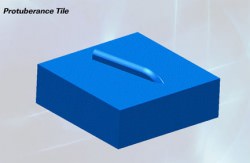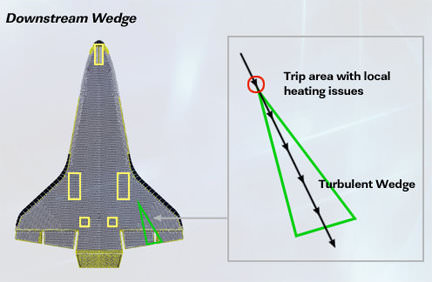[/caption]
In an experiment, one of space shuttle Discovery’s exterior heat tiles was deliberately altered and monitored during the shuttle’s high-speed return to Earth on Saturday. Data was collected to help understand airflow, and provided information for engineers designing the heat shield for the Orion spacecraft. One tile on the bottom of the shuttle’s left wing, about 10 feet behind the leading edge, included a 0.25-inch-high ridge that was expected to cause the airflow to go from smooth to turbulent, causing a rise in temperature of the tiles behind the altered tile. A Navy plane flew below Discovery as it returned home, monitoring the shuttle with an infrared camera. What did the experiment reveal?
Engineers were looking to better understand how smooth, laminar airflow, which provides a thin layer of insulation during peak heating, can change to the disturbed, turbulent flow — called boundary layer transition –which can cause downstream temperatures to climb, possibly affecting aerodynamics and causing damage.
A Navy P-3 Orion aircraft flying over the Gulf of Mexico captured infrared images of the shuttle’s underside when the orbiter had slowed to about 8.5 times the speed of sound. The temperature data and infrared imagery confirmed that the airflow was changed by the modified tile. The insulating layer of air changed to turbulent between mach 12 and 14. That, in turn, caused a rise in the temperatures of downstream tiles, but not as much as was expected.

The tiles in that area of the wing normally experience maximum temperatures of 815-870 degrees C (1,500 to 1,600 degrees F) when the re-entry airflow across the wing is smooth. The preliminary data that NASA received indicated the maximum temperature experienced by the “protuberance tile” was around 1090 degrees C (2,000 F), somewhat less than expected. If those measurements are confirmed, engineers may request a slightly higher protuberance for a future flight.
As for the large area of turbulence seen in the top P-3 image, engineers said said the image likely reflected a “typical” shuttle boundary layer transition during peak heating.
Engineers reported the protuberance tile looked normal and undamaged on the runway after Discovery’s landing, although superficial markings were seen on several downstream tiles. No such markings were seen on tiles behind a protruding gap filler that was spotted during an on-orbit inspection on one of Discovery’s elevons.
The shuttle’s transition from smooth to turbulent flow occurs naturally as the spacecraft slows down, typically at velocities around mach 8, or eight times the speed of sound, about 20 minutes after atmospheric entry begins. In some cases, however, the transition can occur earlier than that because of surface roughness or defects in the heat shield.

For example, a protruding tile spacer called a “gap filler” can shake loose during launch and extend up into the airflow, triggering an early, asymmetric boundary layer transition during re-entry. When that happens, the shuttle’s aerodynamics can be affected and downstream tiles can be subjected to more extreme heating.
During shuttle mission STS-28 in 1989, the boundary layer “tripped” 15 minutes after entry, at around mach 18. During shuttle mission STS-50 in 1992, one side of the shuttle’s belly went turbulent more than a minute ahead of the other side, causing a change in aerodynamics that prompted autopilot flight control inputs.
This experiment that could lead to improved heat shield designs for the Orion spacecraft which will bring astronauts to the ISS and the Moon, along with providing insights into shuttle aerodynamics.
Source: CBS News


The tile is a wonder, yet, it is so fragile in case it gets hit by a piece of eqipement or other things. I hope the next generation or re-useable craft have the tiles built into the craft instead of being pasted on where some wayward equipment or junk may jar it loose and probably causing a serious situation.
“I hope the next generation or re-useable craft have the tiles built into the craft instead of being pasted on where some wayward equipment or junk may jar it loose and probably causing a serious situation.”
I’m not sure what do you mean by ‘built into the craft?”
The current TPS material is a kind of ceramic. it might be impossible to cast in one piece for an entire orbiter (the partially re-useable Orion may also have a segmented heat shield), and as very minor chips and scratches were always seen in post shuttle inspections (some from debris generated in the act of landing), it’s necessary to be able to remove and replace only those sections that need it. Expansion of the aluminum structure beneath also has to be taken into account.
The concern isn’t that a tile will be lost as a unit. The adhesive that secures them is very good. It’s that something may take a *serious* chunk out of one, and the altered airflow may cause localized heating that’s greater than the tile can handle…
Indeed, there was a situation a few missions back,when the felt-like material between two of the tiles had become disloged, and extended above the surface. Engineers debated whether to have a crewman try to cut it off flush, or pull it out completely. The latter was done, the orbiter landed safely.
Now, it would be nice if we had a *metal* that could take these temperatures, but that’s a ways off…
Frank Glover – I understand what you’re talking about=my thinking was to have the tiles then covered, but what I think about will not be feasible as the covering metal will not take the re-entry heat and the craft will be heavier. Thank you for your explanation.
Frank You sound like the person with the knowledge on this subject.
What did the Apollo missions use? It seems that I saw one of the capsules at a Space Museum and it had a one piece heat shield- Of course it was much smaller than the space shuttle and never reused. I have no idea how large the Orion will be- apparently smaller than the current shuttle. ??
Here’s the wiki page on heat shields with some good info.
en.wikipedia.org/wiki/Atmospheric_reentry
The craft is reentring so fast that air can’t move out of the way fast enough. It’s that cushion of air that’s insulating against the most intense heat. Crazy.
What temperatures can titanium take? If not the full temperature, would it give a much greater margin of error or slow airframe brakeup enough to last through the most critical phases?
Layman Says:
March 30th, 2009 at 5:22 pm
What did the Apollo missions use? It seems that I saw one of the capsules at a Space Museum and it had a one piece heat shield- Of course it was much smaller than the space shuttle and never reused. I have no idea how large the Orion will be- apparently smaller than the current shuttle. ??
*****
As Frank says, the tiles sometimes need to be removed and replaced. That is the whole reason behind the heat shield being tiles in the first place. If it was all one piece, any crack or damage to the heat shield would mean literally having to redo the whole exterior. Additionally there is the problem of creating a single piece heat shield that would cover the entire shuttle without any defects.
As for the Apollo mission, they did have a one piece heat shield that was an ablative material that expanded and burned off in the heat during re-entry to keep the capsule from burning up.
So far, all indications are that the Orion crew exploration vehicle is going to go back to the ablative heat shield design used for Apollo (and quite possibly an updated version of the same material due to mass considerations). The design is an enlarged Apollo capsule (16.5 feet in diameter) design that will be able to carry 6 astronauts to the international space station or to a mars-bound spacecraft and 4 astronauts for the moon missions.